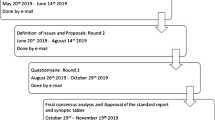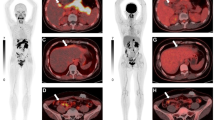Abstract
Objectives
To evaluate the feasibility of equilibrium contrast-enhanced dual-energy CT (DECT), as compared with single-energy CT (SECT) and to calculate extracellular volume (ECV) fraction to predict the survival outcomes of pancreatic ductal adenocarcinoma (PDAC) patients with distant metastases (stage IV) treated with chemotherapy.
Methods
The study cohort included a total of 66 patients with stage IV PDAC who underwent DECT before systemic chemotherapy between July 2014 and March 2017. Unenhanced and 120-kVp equivalent images during the equilibrium phase were used to calculate tumor SECT-derived ECV fractions, and iodine density images were obtained from equilibrium-phase DECT for DECT-derived ECV fractions. Correlations between SECT- and DECT-derived ECV fractions were identified using the Pearson correlation coefficient and Bland–Altman analysis. The effects of clinical prognostic factors and tumor SECT- and DECT-derived ECV fractions on progression-free survival (PFS) and overall survival (OS) were assessed by univariate and multivariate analyses using Cox proportional hazards models.
Results
The correlation between SECT- and DECT-derived ECV fractions was strong (r = 0.965; p < 0.001). The Bland–Altman plot between SECT- and DECT-derived ECV fractions showed a small bias (− 3.4%). Increasing tumor SECT- and DECT-derived ECV fractions were associated with a positive effect on PFS (SECT, p = 0.002; DECT, p = 0.007) and OS (DECT, p = 0.014; DECT, p = 0.015). Only tumor DECT-derived ECV fraction was an independent predictor of PFS (p = 0.018) and OS (p = 0.022) in patients with stage IV PDAC treated with chemotherapy on multivariate analysis.
Conclusions
The ECV fraction determined by equilibrium contrast-enhanced DECT can potentially predict the survival of patients with stage IV PDAC treated with chemotherapy.
Key Points
• Extracellular volume fraction of stage IV pancreatic ductal adenocarcinoma determined by dual-energy CT was strongly correlated to that with single-energy CT (r = 0.965, p < 0.001).
• Tumor extracellular volume fraction was an independent predictor of progression-free survival (p = 0.018) and overall survival (p = 0.022).
• Extracellular volume fraction determined by dual-energy CT could be a useful imaging biomarker to predict the survival of patients with stage IV pancreatic ductal adenocarcinoma treated with chemotherapy.






Similar content being viewed by others
Abbreviations
- CA:
-
Carbohydrate antigen
- CEA:
-
Carcinoembryonic antigen
- CI:
-
Confidence interval
- CTDIvol:
-
CT dose index volume
- DECT:
-
Dual-energy CT
- DLP:
-
Dose-length product
- ECV:
-
Extracellular volume
- ICC:
-
Intraclass correlation coefficient
- IDI:
-
Iodine density image
- OS:
-
Overall survival
- PDAC:
-
Pancreatic ductal adenocarcinoma
- PFS:
-
Progression-free survival
- ROIs:
-
Regions of interest
- SECT:
-
Single-energy CT
- UICC:
-
Union for International Cancer Control
References
Malvezzi M, Carioli G, Bertuccio P et al (2018) European cancer mortality predictions for the year 2018 with focus on colorectal cancer. Ann Oncol 29:1016–1022
Siegel RL, Miller KD, Jemal A (2019) Cancer statistics, 2019. CA Cancer J Clin 69:7–34
Willett CG, Czito BG, Bendell JC, Ryan DP (2005) Locally advanced pancreatic cancer. J Clin Oncol 23:4538–4544
Baxter NN, Whitson BA, Tuttle TM (2007) Trends in the treatment and outcome of pancreatic cancer in the United States. Ann Surg Oncol 14:1320–1326
Tempero MA, Malafa MP, Chiorean EG et al (2019) Pancreatic adenocarcinoma, version 1.2019. J Natl Compr Canc Netw 17:202–210
Yamaguchi K, Okusaka T, Shimizu K et al (2017) Clinical practice guidelines for pancreatic cancer 2016 from the Japan Pancreas Society: a synopsis. Pancreas 46:595–604
Conroy T, Desseigne F, Ychou M et al (2011) FOLFIRINOX versus gemcitabine for metastatic pancreatic cancer. N Engl J Med 364:1817–1825
Javed MA, Beyer G, Le N et al (2019) Impact of intensified chemotherapy in metastatic pancreatic ductal adenocarcinoma (PDAC) in clinical routine in Europe. Pancreatology 19:97–104
Worni M, Guller U, White RR et al (2013) Modest improvement in overall survival for patients with metastatic pancreatic cancer: a trend analysis using the surveillance, epidemiology, and end results registry from 1988 to 2008. Pancreas 42:1157–1163
Wang R, Liu X, Schoepf UJ et al (2018) Extracellular volume quantitation using dual-energy CT in patients with heart failure: comparison with 3T cardiac MR. Int J Cardiol 268:236–240
Ohta Y, Kitao S, Watanabe T et al (2017) Measurement of myocardial extracellular volume fraction from iodine density images using single-source, dual-energy computed tomography: a feasibility study. J Comput Assist Tomogr 41:750–756
Lee HJ, Im DJ, Youn JC et al (2016) Myocardial extracellular volume fraction with dual-energy equilibrium contrast-enhanced cardiac CT in nonischemic cardiomyopathy: a prospective comparison with cardiac MR imaging. Radiology. 280:49–57
Hong YJ, Kim TK, Hong D et al (2016) Myocardial characterization using dual-energy CT in doxorubicin-induced DCM: comparison with CMR T1-mapping and histology in a rabbit model. JACC Cardiovasc Imaging 9:836–845
Bandula S, White SK, Flett AS et al (2013) Measurement of myocardial extracellular volume fraction by using equilibrium contrast-enhanced CT: validation against histologic findings. Radiology. 269:396–403
Sofue K, Tsurusaki M, Mileto A et al (2018) Dual-energy computed tomography for non-invasive staging of liver fibrosis: accuracy of iodine density measurements from contrast-enhanced data. Hepatol Res 48:1008–1019
Zissen MH, Wang ZJ, Yee J, Aslam R, Monto A, Yeh BM (2013) Contrast-enhanced CT quantification of the hepatic fractional extracellular space: correlation with diffuse liver disease severity. AJR Am J Roentgenol 201:1204–1210
Fukukura Y, Kumagae Y, Higashi R et al (2019) Extracellular volume fraction determined by equilibrium contrast-enhanced multidetector computed tomography as a prognostic factor in unresectable pancreatic adenocarcinoma treated with chemotherapy. Eur Radiol 29:353–361
Lin XZ, Wu ZY, Tao R et al (2012) Dual energy spectral CT imaging of insulinoma-Value in preoperative diagnosis compared with conventional multi-detector CT. Eur J Radiol 81:2487–2494
McNamara MM, Little MD, Alexander LF, Carroll LV, Beasley TM, Morgan DE (2015) Multireader evaluation of lesion conspicuity in small pancreatic adenocarcinomas: complimentary value of iodine material density and low keV simulated monoenergetic images using multiphasic rapid kVp-switching dual energy CT. Abdom Imaging 40:1230–1240
Aslan S, Camlidag I, Nural MS (2019) Lower energy levels and iodine-based material decomposition images increase pancreatic ductal adenocarcinoma conspicuity on rapid kV-switching dual-energy CT. Abdom Radiol (NY) 44:568–575
Li C, Lin X, Hui C, Lam KM, Zhang S (2016) Computer-aided diagnosis for distinguishing pancreatic mucinous cystic neoplasms from serous oligocystic adenomas in spectral CT images. Technol Cancer Res Treat 15:44–54
Yin Q, Zou X, Zai X et al (2015) Pancreatic ductal adenocarcinoma and chronic mass-forming pancreatitis: differentiation with dual-energy MDCT in spectral imaging mode. Eur J Radiol 84:2470–2476
Chu AJ, Lee JM, Lee YJ, Moon SK, Han JK, Choi BI (2012) Dual-source, dual-energy multidetector CT for the evaluation of pancreatic tumours. Br J Radiol 85:e891–e898
Noda Y, Goshima S, Miyoshi T et al (2018) Assessing chemotherapeutic response in pancreatic ductal adenocarcinoma: histogram analysis of iodine concentration and CT number in single-source dual-energy CT. AJR Am J Roentgenol 211:1221–1226
Ishigami K, Yoshimitsu K, Irie H et al (2009) Diagnostic value of the delayed phase image for iso-attenuating pancreatic carcinomas in the pancreatic parenchymal phase on multidetector computed tomography. Eur J Radiol 69:139–146
Eisenhauer EA, Therasse P, Bogaerts J et al (2009) New response evaluation criteria in solid tumours: revised RECIST guideline (version 1.1). Eur J Cancer 45:228–247
Benjaminsen IC, Brurberg KG, Ruud EB, Rofstad EK (2008) Assessment of extravascular extracellular space fraction in human melanoma xenografts by DCE-MRI and kinetic modeling. Magn Reson Imaging 26:160–170
De Cecco CN, Ciolina M, Caruso D et al (2016) Performance of diffusion-weighted imaging, perfusion imaging, and texture analysis in predicting tumoral response to neoadjuvant chemoradiotherapy in rectal cancer patients studied with 3T MR: initial experience. Abdom Radiol (NY) 41:1728–1735
Guo J, Reddick WE, Glass JO et al (2012) Dynamic contrast-enhanced magnetic resonance imaging as a prognostic factor in predicting event-free and overall survival in pediatric patients with osteosarcoma. Cancer. 118:3776–3785
Ng SH, Lin CY, Chan SC et al (2014) Clinical utility of multimodality imaging with dynamic contrast-enhanced MRI, diffusion-weighted MRI, and 18F-FDG PET/CT for the prediction of neck control in oropharyngeal or hypopharyngeal squamous cell carcinoma treated with chemoradiation. PLoS One 9:e115933
Tong T, Sun Y, Gollub MJ et al (2015) Dynamic contrast-enhanced MRI: use in predicting pathological complete response to neoadjuvant chemoradiation in locally advanced rectal cancer. J Magn Reson Imaging 42:673–680
Kim PK, Hong YJ, Sakuma H et al (2018) Myocardial extracellular volume fraction and change in hematocrit level: MR evaluation by using T1 mapping in an experimental model of anemia. Radiology. 288:93–98
Pelgrim GJ, van Hamersvelt RW, Willemink MJ et al (2017) Accuracy of iodine quantification using dual energy CT in latest generation dual source and dual layer CT. Eur Radiol 27:3904–3912
Funding
The authors state that this work has not received any funding.
Author information
Authors and Affiliations
Corresponding author
Ethics declarations
Guarantor
The scientific guarantor of this publication is Yoshihiko Fukukura, MD, PhD, Department of Radiology, Graduate School of Medical and Dental Sciences, Kagoshima University.
Conflict of interest
The authors declare that they have no competing interests.
Statistics and biometry
No complex statistical methods were necessary for this paper.
Informed consent
Written informed consent was waived by the institutional review board.
Ethical approval
Institutional review board approval was obtained.
Methodology
• retrospective
• diagnostic or prognostic study
• performed at one institution
Additional information
Publisher’s note
Springer Nature remains neutral with regard to jurisdictional claims in published maps and institutional affiliations.
Rights and permissions
About this article
Cite this article
Fukukura, Y., Kumagae, Y., Higashi, R. et al. Extracellular volume fraction determined by equilibrium contrast-enhanced dual-energy CT as a prognostic factor in patients with stage IV pancreatic ductal adenocarcinoma. Eur Radiol 30, 1679–1689 (2020). https://doi.org/10.1007/s00330-019-06517-w
Received:
Revised:
Accepted:
Published:
Issue Date:
DOI: https://doi.org/10.1007/s00330-019-06517-w




